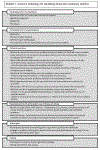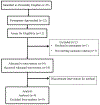Assistive technology self-management intervention for older Hispanics: a feasibility study
- PMID: 31172826
- PMCID: PMC6898773
- DOI: 10.1080/17483107.2019.1621954
Assistive technology self-management intervention for older Hispanics: a feasibility study
Abstract
Purpose: Even though assistive technology (AT) can overcome disabilities, Hispanics are among the least likely to use AT. We aimed to assess the feasibility of an assistive technology AT and disability self-management intervention concerning recruitment, retention, adherence, acceptability, preliminary evaluation of participants' responses to intervention and preliminary efficacy.Methods: We used mixed-method intervention design with a pre- and post-test quantitative model with an experimental intervention and qualitative data obtained after the intervention. Ten older Hispanics were enrolled in an eight weeks group intervention. Instruments to measure feasibility and pre/post participants' report outcomes of quality of life (Psychosocial Impact of Assistive Device Scale [PIADS] Short Form), global health (PROMIS General Health Short Form), self-efficacy (Self-efficacy Scale) and performance difficulties (Individualized Prioritized Problem Assessment [IPPA]) were used.Results: Recruitment, retention and adherence rates were high, the intervention was acceptable, and the participants reported outcomes, such as: new knowledge and skills, enhanced activity performance and participation, increased safety and willingness to use AT, decreased performance difficulties and enhanced quality of life.Conclusion: The intervention was feasible and acceptable and is promising in decreasing performance difficulties in daily activities as well as in having a positive impact in older Hispanics' quality of life.IMPLICATIONS FOR REHABILITATIONOlder Hispanics living in Puerto Rico experience a high prevalence of disabilities in independent living.In a relative small sample this study shows that an assistive technology (AT) and disability self-management intervention for older Hispanics living in Puerto Rico is feasible to be delivered in a group format and in the community context.Older Hispanics living in Puerto Rico can potentially decrease performance difficulties in daily living activities and improved their quality of life through assistive technology and disability self-management interventions.
Keywords: Hispanics; Self-help devices; activities of daily living; frail elderly; independent living; therapeutic use.
Conflict of interest statement
Disclosure statement
No potential conflict of interest was reported by the authors.
Figures



Similar articles
-
Assistive technology unmet needs of independent living older Hispanics with functional limitations.Disabil Rehabil Assist Technol. 2018 Feb;13(2):194-200. doi: 10.1080/17483107.2017.1300693. Epub 2017 Mar 22. Disabil Rehabil Assist Technol. 2018. PMID: 28326905 Free PMC article.
-
Multilevel barriers to using assistive technology devices among older hispanics from poor and disadvantaged communities: the relevance of a gender analysis.Disabil Rehabil Assist Technol. 2024 Apr;19(3):682-698. doi: 10.1080/17483107.2022.2117427. Epub 2022 Sep 28. Disabil Rehabil Assist Technol. 2024. PMID: 36170426 Free PMC article.
-
Assistive technology and telecare to maintain independent living at home for people with dementia: the ATTILA RCT.Health Technol Assess. 2021 Mar;25(19):1-156. doi: 10.3310/hta25190. Health Technol Assess. 2021. PMID: 33755548 Free PMC article. Clinical Trial.
-
The impact of assistive living technology on perceived independence of people with a physical disability in executing daily activities: a systematic literature review.Disabil Rehabil Assist Technol. 2024 May;19(4):1262-1271. doi: 10.1080/17483107.2022.2162614. Epub 2023 Jan 10. Disabil Rehabil Assist Technol. 2024. PMID: 36628433
-
Toward user-centered assistive technologies for aging in place with cognitive impairment: a survey.Disabil Rehabil Assist Technol. 2024 May;19(4):1561-1567. doi: 10.1080/17483107.2023.2217848. Epub 2023 Jun 2. Disabil Rehabil Assist Technol. 2024. PMID: 37267121 Review.
Cited by
-
Implementation of digital health technologies for older adults: a scoping review.Front Aging. 2024 May 7;5:1349520. doi: 10.3389/fragi.2024.1349520. eCollection 2024. Front Aging. 2024. PMID: 38784681 Free PMC article.
-
Enhancing Older Adults' Lives Through Positive Aging Perception, Quality-of-Life Enhancement, and Social Support to Drive Acceptance and Readiness Toward Indoor Assistive Technology: Cross-Sectional Study.JMIR Aging. 2025 Feb 5;8:e59665. doi: 10.2196/59665. JMIR Aging. 2025. PMID: 39908542 Free PMC article.
References
-
- Bureau USC. National Population Projections. U.S. Census Bureau, Population Division; Washington, D.C.: 2012. Table 6. Percent of the Population by Race and Hispanic Origin for the United States: 2015 to 2060. 2012.
-
- Freedman VA, Spillman BC. Disability and care needs among older Americans. Milbank Q [Internet] 2014;92(3):509–41. Available from: http://www.pubmedcentral.nih.gov/articlerender.fcgi?artid=4221755&tool=p... - PMC - PubMed
-
- Erickson W, Lee C, Schrader S. Disability Statistics from the 2013 American Community Survey (ACS) [Internet] Ithaca, NY: Cornell University Yang-Tan Institute (YTI) 2017. [cited 2017 Jul 14]. Available from: http://www.disabilitystatistics.org
-
- Kaye HS, Yeager P, Reed M. Disparities in usage of assistive technology among people with disabilities. Assist Technol [Internet] 2008;20(4):194–203. Available from: http://www.ncbi.nlm.nih.gov/pubmed/19160906 - PubMed
-
- Ripat J, Woodgate R. The intersection of culture, disability and assistive technology. Vol. 6, Disability and Rehabilitation: Assistive Technology. 2011. p. 87–96. - PubMed
Publication types
MeSH terms
Grants and funding
LinkOut - more resources
Full Text Sources
Medical
